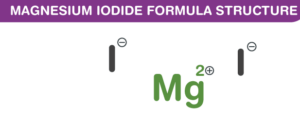Magnesium iodide, an intriguing inorganic compound, has captivated the attention of chemists and researchers due to its distinct properties and versatile applications. In this exploration, we will delve into the comprehensive understanding of its fundamental properties, delve into the intricacies of its chemical structure, and illuminate the distinctive characteristics that define this compound.

Introduction
Magnesium iodide, denoted chemically as MgI2, is a remarkable ionic compound composed of magnesium cations (Mg^2+) and iodide anions (I^-). This compound’s structure is foundational to comprehending its behavior and reactivity in various chemical contexts. The arrangement and interaction of these ions play a crucial role in dictating their properties and applications.
Chemical Structure and Bonding
The chemical structure of magnesium iodide is an intriguing realm of ionic bonding, a fundamental and pervasive type of chemical bonding primarily found in salts. This essential bonding occurs between the positively charged magnesium cations (Mg^2+) and the negatively charged iodide anions (I^-). The magic happens when these charged entities are drawn towards each other due to their opposite charges, resulting in a robust, stable, and distinctive crystalline lattice structure.
In this lattice structure, each magnesium cation, carrying a +2 charge, is surrounded by multiple iodide anions (I^-), and vice versa. This mutual attraction and arrangement of ions create a lattice, akin to a three-dimensional jigsaw puzzle. The beauty of ionic bonding lies in its stability, which arises from the strong electrostatic forces of attraction between these oppositely charged ions.
Physical Properties: Insights into Magnesium Iodide’s Behavior
Understanding the physical properties of magnesium iodide provides valuable insights into how this compound behaves under varying conditions, which is instrumental in determining its applications and uses.
1. Appearance
Iodomagnesium typically presents itself as a pristine white, crystalline solid, showcasing its purity and chemical composition. These crystals exhibit a characteristic luster, further aiding in its easy identification and differentiation from other substances.
2. Melting and Boiling Points
The melting and boiling points of magnesium iodide are remarkable. At approximately 637 degrees Celsius, it transitions from a solid to a liquid state, showcasing its stability even under high-temperature conditions. This property is fundamental in various applications, especially those involving elevated temperatures.
3. Solubility
One of the essential physical properties of magnesium Salt of Hydriodic Acid is its solubility in water. When introduced to water, it readily dissolves, forming a clear solution. This high solubility is a pivotal factor, particularly in solution-based chemistry and reactions. It enables the compound to seamlessly integrate into various aqueous environments, expanding its range of applications in the chemical and industrial sectors.
Understanding these physical properties provides researchers with a foundational knowledge of how magnesium iodide interacts with its surroundings. Whether in its solid state, undergoing phase transitions, or dissolved in a solution, these properties play a crucial role in shaping its behavior, applications, and relevance in the realm of chemistry and beyond.
Chemical Characteristics
Analyzing the chemical characteristics of magnesium iodide gives a deeper understanding of its behavior in chemical reactions:
- Reactivity: Magnesium iodide exhibits a degree of reactivity, particularly in reactions where the iodide ion participates. This reactivity is pivotal in various chemical processes, including synthesis and catalytic reactions.
- Participation in Synthesis: Magnesium iodide serves as a catalyst in certain chemical reactions and is a vital component in the synthesis of organic compounds. Its involvement in these processes contributes to the production of essential compounds used in various industries.
- Compatibility with Other Compounds: Understanding how magnesium iodide interacts with other compounds is essential for predicting its behavior in diverse chemical environments. It can form various complexes and compounds, showcasing its versatility.
Applications and Uses
Magnesium iodide finds applications in a multitude of domains due to its unique properties:
- Medicine: In the field of medicine, the magnesium salt of Hydriodic Acid is used for iodine supplementation, especially in regions where iodine-deficient diets are prevalent. It provides a crucial source of iodine, which is essential for thyroid function and overall health.
- Chemical Synthesis: Magnesium iodide is a valuable reagent in organic synthesis. It facilitates the creation of important organic compounds used in pharmaceuticals, plastics, and other industries. Its catalytic properties make it a powerful tool in chemical transformations.
- Research and Development: Researchers extensively use magnesium iodide in laboratories for various experiments and processes. Its unique properties and compatibility with other compounds make it an invaluable substance in research and development efforts.
Conclusion
In conclusion, delving into the fundamental properties, chemical structure, and characteristics of magnesium iodide provides a comprehensive understanding of this fascinating compound. The intricate interplay of its ions, both physically and chemically, underscores its versatility and importance in various scientific and industrial applications. Magnesium iodide’s distinct properties continue to fuel exploration and innovation, positioning it as a vital component in the ever-evolving world of chemistry.


